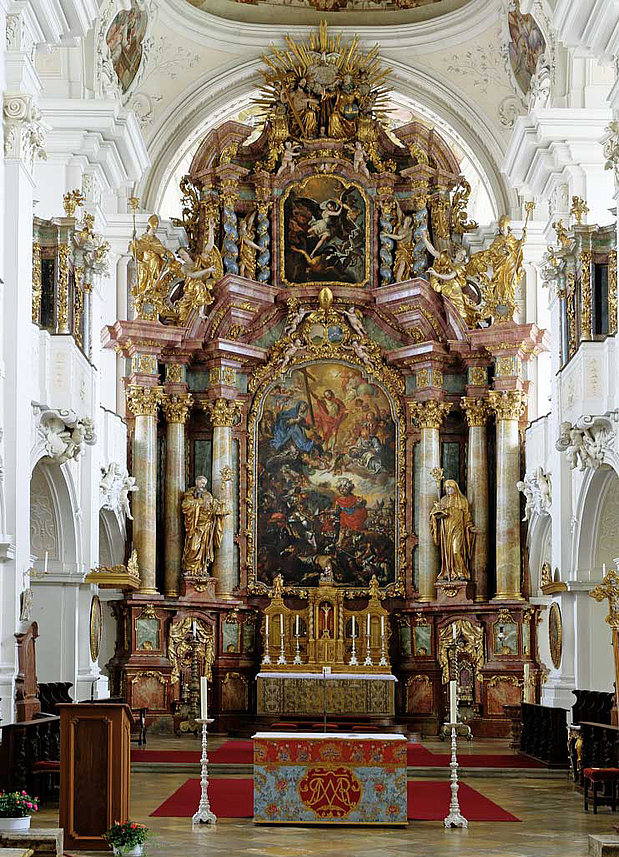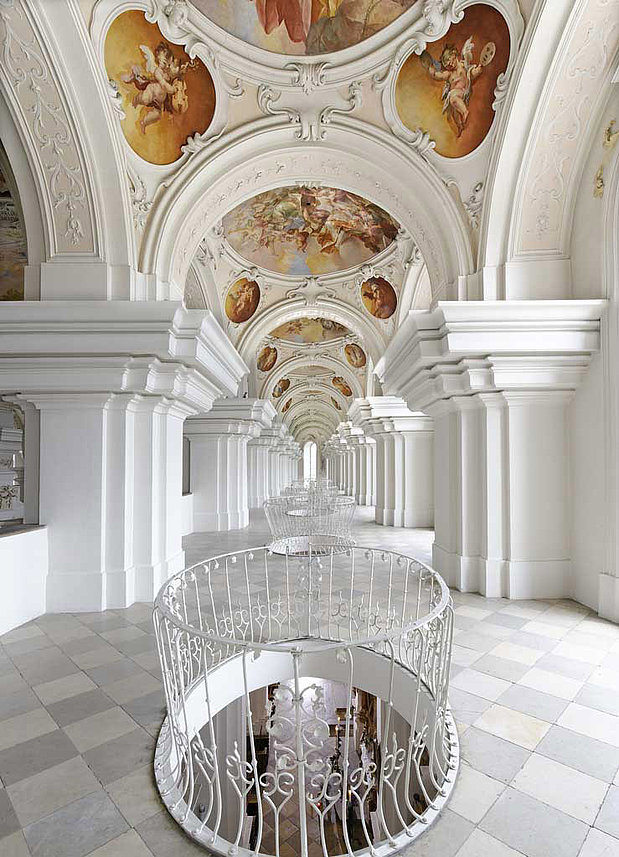The St. Mauritius Basilica in Niederaltaich
For the past 700 years, our large majestic Basilica has been the dominant feature of the pastoral Lower Bavarian region - where the Isar River joins the Danube. Much like the ancient wayfarer who saw the Basilica's massive twin towers as a focal point, the modern-day traveler, driving on the Passau/Regensburg expressway, which runs nearby our monastery, can't avoid seeing the beacon-like twin towers.
At the behest of Abbot Joscio Hamberger (1700-1739), the original Gothic hall-shaped church, completed in 1270, was renovated in a Baroque style in 1720. Abbot Joscio's renovation measures proved to be both successful and enduring.
Today, almost three centuries after the initial renovation, our Basilica counts as one of the most remarkable and accomplished examples of South German Baroque church architecture.
The Basilica's impressive skywards arching interior design, its unobtrusive stucco pillars, columns and archways, and its over two hundred colourful frescoes (created by Wolfgang Andreas Heindl from Wels, Upper Austria) are enchanting and captivating.
The oval-shaped ceiling openings are especially striking and highly unusual. These porthole-like openings, encircled with an ornately constructed iron oval fence, are located directly above the side altars along the right and left side walls of the Basilica. From the upper church, looking downwards through one of the openings, one looks - with a bird's eye view - directly onto a side altar with its venerated saint. From one of the ground floor side altars, looking upwards through the ceiling opening, one sees, about 20 m overhead, a ceiling fresco that symbolically refers to the side altar's venerated saint. For example, the ceiling fresco directly above the Mother Of God altar employs an usually rare image symbolizing the Virgin Mother's edifying and life-giving grace. The altar itself is a pieta, depicting a 1480 sandstone sculpture of the Virgin Mother holding the body of her crucified son in her lap. The altar's ceiling fresco shows drops of milk flowing from the Holy Mother's partially concealed breast. From the ground floor, looking up through the oval-shaped ceiling opening, one has the impression that much like the sacramental blood and water flowing from her crucified son's abdomen wound, the Virgin's milk flows as a Holy Blessing to the people below.
One area of the Basilica demanding our undivided attention is the magnificently designed and decorated sacristy. As a result of the 1803 secularisation measures, some of the Basilica's interior artefacts (e.g., furnishings, sculptures and altars) were either destroyed, stolen or sold. The sacristy, however, is the Basilica's only room or chamber that survived the secularisation campaign completely unscathed. Therefore, it is justifiably regarded to be unique in all of Bavaria.
Just like in Franz Geiger's 1675 exceptionally expressive high altar painting depicting the martyrdom of St. Mauritius and his ascension into heaven (a beam of light is employed to represent heavenly Providence. Above the beam, the Holy Family is waiting to receive the martyred Saint), many of the Basilica's ceiling frescoes, especially those directly above the side altars, also depict heavenly scenes as the Land of Promise, waiting to accept those of us who, like St. Mauritius, kept the faith, despite grave earthly trials and tribulations.
In this regard, the Basilica's ceiling frescoes and the numerous paintings bears witness to the three fundamental dimensions of Christian life. Firstly, the trials and tribulations of earthly life as a period of preparation for the After Life. Secondly, death not as the telos of life, but rather a gateway leading to the final and most central aspiration of Christianity - namely, the Resurrection of the body and the eternal life.
Above the Basilica's indoor entrance, one finds an Old Testament quotation: "Holiness becometh thine house, O Lord, for ever." (Psalm 93,5 King James Version)
However beautiful the Basilica's interior, the aim and purpose is not simply art appreciation, but rather, as mandated by indoor entrance Psalm, the glorification of God and the use of His House as a place of worship.
The magnificence of our Basilica is not revealed in its art treasures, but in the daily prayers of the faithful who daily dignify the over 1250 year history of our house of worship, "The Holy Altach."
Virtual Tour of the Baroque Basilica



